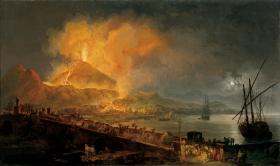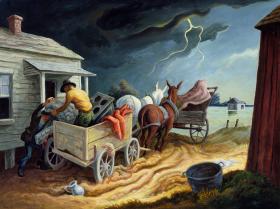- Explore the term force as a class through discussion and example. (You may use a bowling pin and ball to demonstrate the impact of force on a still object. Use different types of balls if you wish to demonstrate different speeds and impact.) Describe the action of forces and the changes that action brings about. Ask students to help you brainstorm a list of forces that occur in nature (rain, wind, fire, etc.). Make a second list of the outcomes that often result from these forces (floods, power generation, movement of plants and seeds, etc.). Discuss ways students might measure these forces (wind speed, rain fall, temperature).
- Discuss the focus works of art with students. Why are the people moving? What is making them flee the scene? How do natural forces impact (or change) the environment, humans, and other creatures? Ask students to look for examples of movement in the works. What did the artists use to show the movement caused by these natural forces? Ask students to describe the events that precede the moment depicted in each painting and what is about to happen in the scenes.
- Handing out collage materials (torn paper, yarn scraps, etc.) and crayons/markers, have students create a multimedia artwork that helps them explore one natural force and the movement associated with it. How could they best show this natural force at work? What would it look like? (If necessary, have students research photographs of natural forces at work.) Would the student be in the picture? Would there be other people in the picture? Or, would there be some kind of object, such as a tree, car, ship, house? How would they respond to the force? What movement would be occurring?
- Students will write and illustrate a descriptive paragraph about a superhero who possesses the powers of the natural force they selected in step 3. They will describe the way that superhero impacts the people and places around him/her.
- Participation in group discussion, collage, and superhero story will demonstrate student's understanding of forces.
- Participation in group discussion, collage, and superhero story will demonstrate student's ability to identify human responses to forces of nature.
- Participation in group discussion of work of art will be used to assess student's ability to identify movement in a work of art.
- Collage and story illustrations will demonstrate student's ability to incorporate movement into a work of art.
- Collage: an image or composition made by gluing onto a flat surface fragments of cut or torn material, such as various types of paper or cloth, to which drawn or painted elements may be added
- Force: strength, power, intensity of effect; a push or pull between two objects
- Landform: a physical feature of the earth's surface, such as a hill or plain
- Movement: a change of place, position or posture; in painting or sculpture: the quality of conveying an impression of action or motion
- ball and bowling pin
- collage materials (torn paper, yarn scraps, etc.)
- crayons/markers
The erupting volcano is the bright focus of Volaire's painting. Our eye moves from this hot explosion down the mountain in a zigzag motion, following the ooze of the molten lava. Our attention comes to rest on a village and port at the base of the volcano. Townspeople flee across a diagonal bridge to safety on the other side of the bay. The scurry of activity increases the drama of the event and connects us emotionally with the scene. The painting demonstrates Volaire's careful observation of the volcano's physical characteristics, as well as the human response to disaster.
Who was this made for?
Volaire created more than thirty scenes of Mt. Vesuvius for British travelers who traveled to Naples, Italy, to visit the ruins of Pompeii and witness the awesome spectacle of the active volcano. These paintings, like today's picture postcards, were souvenirs of the travelers' visits to this popular destination. Some of them simply document the physical features of the erupting volcano, while others like this one represent the volcano's menacing effect on local townspeople. Volaire's painting was commissioned by a British patron, who also owned a large collection of ancient sculpture.
Why was the volcano so popular?
Mt. Vesuvius erupted periodically throughout the 1770s. Tourists, scientists, and artists traveled to Naples to marvel at and document this natural phenomenon. At the time, Enlightenment thinkers promoted the careful examination of nature in order to understand its awesome character and frightening potential. Visitors to Naples usually observed details of the volcano from a safe distance, removed from the heat and spew of the crater. However, a few like Volaire were brave enough to climb up the volcano to investigate and document the features of this fiery mountain.
Two sharecroppers struggle to load their meager belongings--mattress, cast-iron stove, and blanket--into a mule wagon before rising floodwater reaches their small home. A darkening sky and lightning add a sense of urgency to their actions. Deep furrows in the mud and high water in the background suggest escape will be difficult. Benton used compositional elements, such as color, line and shape, to increase the drama of his painting. He squeezes the activity of the scene between two wooden structures--the white house on the left and the red barn on the right. He crops our view of these buildings, as a photographer does when zooming in on the action. This helps narrow our focus on the rectangular wagon, which repeats the shape and texture of the buildings. Benton also uses color to direct our attention to the wagon. The yellow of the man's shirt and the orange blanket catch our eye and encourage us to take inventory of the items being loaded. The artist also repeats round objects, such as the white jug, wagon wheels, metal tub, and horses' bodies, to move our eye from the foreground to the middleground of the painting. Diagonal lines in the mud and streaks of lightning suggest action and heighten anticipation about the outcome of this story. This drama is accentuated by the contrast of dark clouds on the left and clear sky on the right.
Does this painting document a real occurrence?
This painting is based on drawings Thomas Hart Benton made on travels in the Midwest during the Great Flood of 1937. He was hired by the Kansas City Star newspaper to document this natural disaster, which ravaged much of the Ohio River Valley. He traveled through Missouri making sketches of the flood's effect on the land and its residents. He wrote, "The roads of the flood country were full of movers... Every once in a while seepage from under the levee would force the evaculation of a house and you would see a great struggle to get animals and goods out of the rising water."
What is Thomas Hart Benton's background?
Thomas Hart Benton was born in Missouri and went to art school in New York. Rejecting the abstract style popular in modern Europe and America, he chose to paint in a more illustrative manner. He is part of an art movement called American regionalism, characterized by images of everyday subjects that celebrate the virtues and struggles of rural America.



